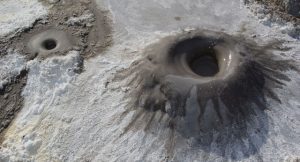
The nature of the sediments on the Basque continental shelf is very heterogeneous. From the point of view of distribution, two clearly differentiated sectors can be picked out in terms of grain size. “In the area of Bizkaia medium to coarse-sized sands predominate, whereas on the coast of Gipuzkoa there is a predomination of deposits of very fine sand, silts and clays, currently known as the Basque Mud Patch (BMP),” explained Maria Jesus Irabien, researcher in the UPV/EHU’s Department of Mineralogy and Petrology.
“This mud patch has an irregular surface area of approximately 680 km2. Metals and contaminants, in general, are more likely to build up in this type of muddy material. So if what we are aiming to do is study anthropogenic, industrial or human influence, it is necessary to explore the mud patch in the area of Gipuzkoa,” said the researcher in the Harea: Coastal Geology group of the UPV/EHU.
So, as Irabien pointed out, “we analyzed three cores (19-46 cm deep) from a multidisciplinary perspective that includes the analysis of various metals, foraminifera (small organisms characterized by a shell or chalky conch), pollen and various natural and artificial isotopes”.
“The results obtained have made it possible to calculate that the sediments build up at an approximate rate of one millimeter per year. An increase in the concentrations of metals from the end of the 19th century onwards can also be observed, showing that the influence of industrialization and human activity taking place in the Basque Country extends to the marine environment. In the case of lead (Pb), for example, the content in the most recent samples is five times higher than in that recorded in the past. However, the foraminifera are not affected by this contamination. Finally, the pollen analysis displays a growing trend in conifers and a reduction in indigenous species (Deciduous Quercus), possibly as a result of reforestation,” highlighted the researcher of the Harea: Coastal Geology group of the UPV/EHU.
“The results confirm that the influence of coastal anthropogenic activities extends to the adjacent shelf where muddy deposits are likely to act as a trap for contaminants,” said Irabien.
The researcher stresses “the importance of continuing to make interpretations of this type in marine depths to get to know marine evolution from a historical perspective. It is clear that human activity is exerting a significant influence on the coast, too; the only advantage that all this has is knowing we can stop,” concluded María Jesús Irabien.
Reference:
María Jesús Irabien et al, Recent coastal anthropogenic impact recorded in the Basque mud patch (southern Bay of Biscay shelf), Quaternary International (2020). DOI: 10.1016/j.quaint.2020.03.042
Note: The above post is reprinted from materials provided by University of the Basque Country.










